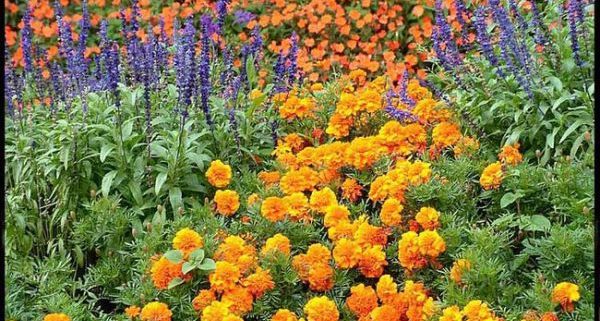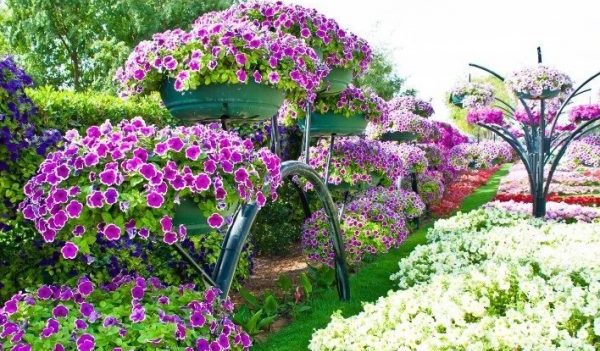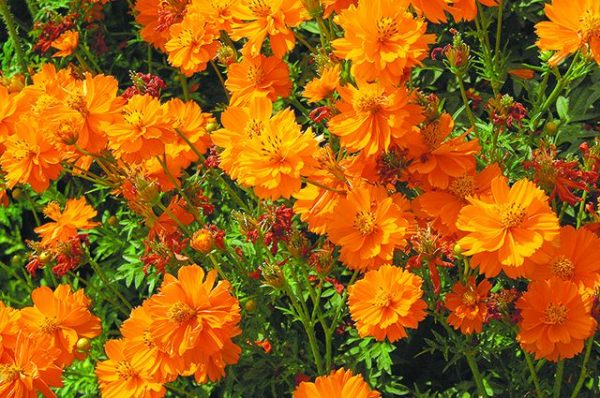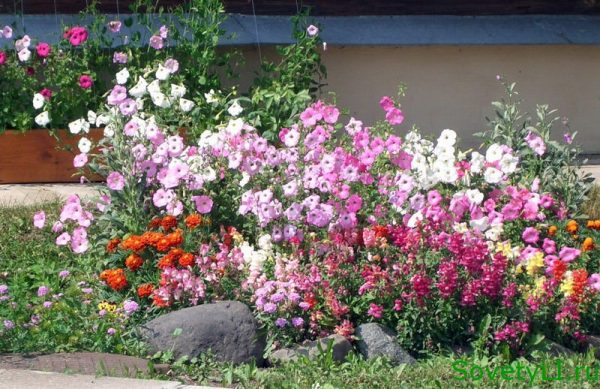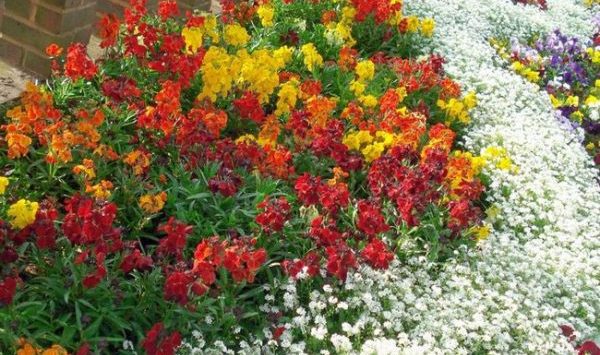Annual flowers in the country blooming all summer
Content
Pros of flowers blooming all summer
Annual flowers are convenient because every year you can update the colors, change the arrangement, that is, re-create small masterpieces. Lush blooming annuals hide the withering of perennial flowers and plants, cover workers' buildings from prying eyes. Moreover, annual plants are less whimsical to living conditions - it remains only to be attentive to their small wishes in order to get beautiful beds in the country. Whatever your requests, during the season you can easily fulfill them using one-year-olds.
Annuals are more diverse in shape and color, given their unpretentiousness, this will allow you to place a variety of flowers in the neighborhood. They do not need to be prepared for winter, because it is much easier to re-plant next year than trying to maintain the current planting. The pluses are also worth writing down the small space they take up.
But by far the most important argument is the flowering period. Most annuals bloom in the spring and only fade in late autumn, which means that a riot of colors and aromas reigns in your garden for 6-7 months. One-year-olds are especially relevant for Siberia, where summer is fleeting and perennial flowers simply do not have time to bloom properly.
Video "A selection of options for gardeners"
Video selection of various varieties for gardeners and summer residents.
How to choose
As soon as it occurred to you: "I want a flower garden!" - it's time to figure out how seeds are chosen, where it is better to plant flowers, how to take care of them. Having stopped your choice on certain varieties of flowers, before buying seeds, carefully study the period of their flowering, color combinations, the place that is best suited for planting. It is important to take into account the flowering period (beginning and end) so that it does not turn out - half of the flower bed has already bloomed, and the second is not even going to. Garden early flowering plants: begonia, petunia.
In early summer, bloom: zinnia, marigolds, cornflowers, lobelia. Until late autumn, they delight with flowering: calendula, aster, lavatera, snapdragon. Remember that flowers differ not only in the shape and color of the petals, but also in height. Arrange flowers of different heights for beautiful combinations.
The landing site is also very important, but it depends on what requirements you set. For the front garden, give preference to marigolds, nasturtium or cornflowers. Curly flowers are suitable for walls, fences, fences: decorative sweet peas, morning glory, bindweed. Ampel flowers such as petunia, geranium, lobelia are suitable for hanging pots. Most annual plants are very fond of sunlight, good watering. Make sure your garden beds are abundant.
Color combinations are an important element when combining different colors. Considering the height and color, you can create stunning compositions. Purple flowers go well with white, blue and maroon. White - go with everyone. Reds and all shades of pink create an energetic composition with oranges and yellows. Every year there are more and more shades, color combinations. A little perseverance when planning your flower beds will bring you charming flower beds and delight from guests.
Overview
Before proceeding with a review of the flower variety, it is worth clarifying that the seeds that you purchase for planting must be from trusted manufacturers. There is nothing worse than shelling out a tidy sum for seeds and getting barren flowers or diseased plants. If you do not know anything about the manufacturer, for reinsurance, sow a double, or even a triple portion.
Flowering plants differ among themselves in the height to which they can grow, therefore they are divided into undersized, medium-sized and tall.
Tall annuals
These are real giants of their kind, the height of the stems reaches 1.5-2 m. They are used for specimen compositions or group plantings. Some are curly, others require a garter, so take care to install the support structure before planting.
Probably one of the most common types of tall annuals is Datura, or in the common people Datura-grass. A sun-loving plant with a thick aroma, it stretches up to a meter in height. She has beautiful bell-shaped flowers and rich colors: yellow, red, blue or white. The flowering period of the date is from June to October.
Delphinium is unpretentious to the landing site. Its seeds germinate well, so you can plant it directly in your garden. Delphinium goes well with terry mallow, castor oil plant.
Morning glory - liana with stems about 2-3 m, perfectly decorate any fence or hedge. It grows into dense thickets, and given that the flowers bloom early in the morning, it turns out a wonderful hedge with fragrant flowers that will delight the eye in the morning. Kobeya is a liana with many tenacious tendrils, on a stable support it grows up to 4-6 m. It blooms at the end of June, releasing large purple bell-shaped flowers.
Another unpretentious champion is nasturtium. The classic color of nasturtium is orange, but the selectors brought out pink, yellow, cream, dark red varieties. It grows up to 3 m and will perfectly complement any ampelous compositions. Annual mallow with good watering reaches a height of 1.3 to 2 m. Terry inflorescences come in different colors, but the most beautiful are pale pink and purple buds. By the way, in order to prolong the flowering of mallow, you need to remove the faded inflorescences.
Medium-sized
Medium-sized varieties include those who do not grow taller than 80 cm. Typically, such plants are used to form and decorate mixborders, flower beds, parterres. With medium-sized flowers, it is important to determine whether the flowers will be combined in shape and color.
Kosmeya - has shiny flowers, large openwork foliage. It blooms from mid-July and, if planted in the sun, pleases with an abundance of flowers. Esholzia - characterized by lush bushes 50-60 cm in height with orange or yellow poppy-like inflorescences. Blooms in mid-summer, but blooms until the first cold weather.
Marigolds are lovers of the sun and good watering. Depending on the variety, they grow up to 1 m. These flowers form lush bushes with yellow, red or orange flowers, shaped like a ball. Calendula, or in the common people - marigolds, is a champion in resilience, since it blooms until November. To get a dense flowering, it is worth planting it in a place open to the sun's rays, but if you need a dense hedge 20-30 cm in height, then plant it in the shade.
Garden beds get a real riot of colors with the appearance of the Majors. Bright flowers in the shape of baskets will delight both in the scorching heat and in cloudy rainy weather. The abundance of color options makes the Majors the perfect companion for any arrangement.
Salvia will provide the flower beds with tall flower candles. Usually the flowers are deep blue, but there are also purple ones. Kosmeya - with its unpretentiousness to living conditions, it grows into lush bushes with many bright colors. But at the same time, the bushes look incredibly fragile due to the shape of the leaves. Perfect for forming a hedge or masking outbuildings.
Stunted
Low-growing annual varieties rarely grow taller than 30 cm, but it is because of this that their seeds are so popular. Neat, low flowers look graceful and are able to fill any space between their taller brethren. Ageratum - forms undersized carpets of many shades from white to rich lilac. It blooms in early summer and pleases with an abundance of flowers until late autumn.
Iberis - differs in inflorescences in the form of umbrellas, represents undersized climbing herbaceous plants. It is extremely unpretentious, and therefore even more desirable in flower arrangements. Lobelia - blooms all summer, goes well with petunia. It blooms in multiple small inflorescences, regardless of sunlight. The undersized Lobelia bushes are pleasing to the eye and perfectly complement any flower bed.
Petunia is a regular in hanging compositions. Due to the fact that petunia blooms all summer and most of autumn, it is used as a decorative element not only in the garden, but also in urban settings. Low-growing, spreading bushes look great in hanging pots. Whatever the needs of the gardener, there are always about a dozen varieties that will satisfy his or her needs. The main thing is to buy seeds from trusted producers and let your imagination fly free.
Video "Recommendations for choosing and caring for one-year-olds in the country"
An informational video with useful tips and advice on choosing a variety of annuals and caring for them for gardeners and summer residents.

